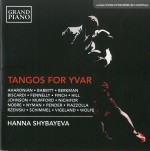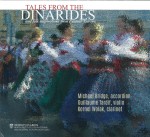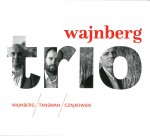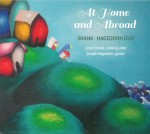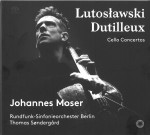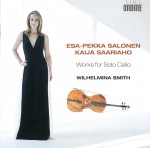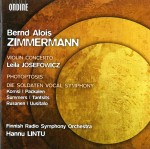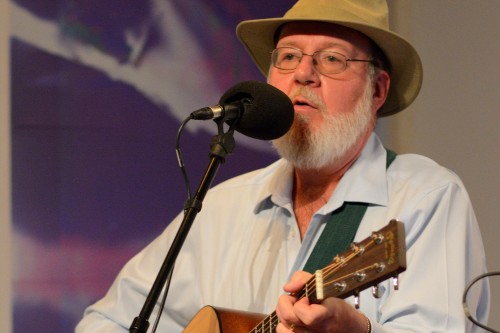Editor's Corner - September 2019
In the summer issue we published Alex Baran’s final column, which is sad news indeed for me and has made my job as assignment editor a bit more onerous. But as far as I know, there is no grave understory to his announced retirement, it was simply time to move on and focus on other things. During the past decade he contributed a variety of reviews to The WholeNote – his first pair appeared in December 2009 – but for the past four years he has focused on keyboard recordings under his own Keyed In masthead.
As with Terry Robbins’ Strings Attached, Alex’s column simplified my editorial duties by enabling me to ship out any and all applicable discs to him and leave sorting out their relevance to his discretion. It always amazed me how Alex could write about a dozen discs each month and make them all sound individual, finding positive aspects to each performer’s approach and describing them in terms as nuanced as the recordings he was writing about.
Although my WholeNote relationship with Alex goes back a decade, my professional association with him dates back to the early 1990s when I was a music programmer at CJRT-FM where he was an on-air host and later program director. I worked closely with him writing scripts for CJRT Concert and selecting recordings for Music for Midday for five years at what I still consider to be, New Music Concerts and The WholeNote notwithstanding, the best job I’ve ever had (and the only one that generated a pension thanks to its affiliation with Ryerson University).
So that being said, I will miss Alex’s insights and his diligence. For the moment you will find the Keyed In banner maintained, with a number of writers contributing their own insights, both seasoned WholeNote reviewers and some new voices. In this issue I’m very pleased that outstanding young Toronto pianist, Adam Sherkin, has taken on three discs in his WholeNote debut, and I think you’ll agree he is an excellent addition to our team. Welcome Adam!
To keep this “all about me” as is my wont, I’ll mention that some of the highlights of my career at CJRT included selecting the music for Peter Keigh’s Music before 1800, working with engineer William van Ree to record the live performances that aired on CJRT Concert, doing on-air interviews with celebrities such as Ben Heppner for This Week In Music and producing a week-long tribute to Tālivaldis Ķeniņš (a distinguished Latvian-Canadian composer mentioned in the Canadian Amber review later on in these pages). It was not all “days of wine and roses” however. Occasionally my penchant for contemporary music would land me in hot water for programming music a little too strident for the mainstream tastes of our core listeners (and the management). One notable instance was selecting Canadian composer Henry Kucharzyk’s Figure in a Landscape, a 32-minute orchestral work written for choreography by Christopher House at Toronto Dance Theatre. I thought its performance by the National Arts Centre Orchestra under Trevor Pinnock provided enough classical credibility, but it ultimately proved a bit “much of a muchness” for Music for an Afternoon and host Adriane Markow. I did not program it in isolation, however, and cleverly, I thought, had it follow Schumann’s Carnaval, a 30-minute piano suite whose opening chord sequence is exactly mimicked, although one tone higher, in Kucharzyk’s orchestral score. I’m not sure if anyone else noticed the similarity, but to me it provided a significant entry point into the modern work. It was this sort of jigsaw-puzzle placement of pieces that provided real satisfaction in my job as music programmer.
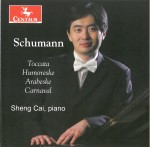 All this seems a long introduction to the first disc I’ll write about, but you’ll see the connection in a moment. In one of the eerie synchronicities that I have mentioned before, while editing this month’s Keyed In, I had just finished Roger Knox’s review of Sheng Cai’s ATMA release of Liszt etudes when I received an email from that distinguished young Chinese-Canadian pianist himself. He said he was writing at the suggestion of producer Keith Horner to tell me about his album Robert Schumann Piano Music that has recently come out on the Centaur label (CRC 3696 naxosdirect.com). I told him that seemed strange because we were reviewing his Liszt CD in the coming issue. He explained that although recorded at Glenn Gould Studio in 2017, Centaur had some problems with the release and it was delayed nearly two years.
All this seems a long introduction to the first disc I’ll write about, but you’ll see the connection in a moment. In one of the eerie synchronicities that I have mentioned before, while editing this month’s Keyed In, I had just finished Roger Knox’s review of Sheng Cai’s ATMA release of Liszt etudes when I received an email from that distinguished young Chinese-Canadian pianist himself. He said he was writing at the suggestion of producer Keith Horner to tell me about his album Robert Schumann Piano Music that has recently come out on the Centaur label (CRC 3696 naxosdirect.com). I told him that seemed strange because we were reviewing his Liszt CD in the coming issue. He explained that although recorded at Glenn Gould Studio in 2017, Centaur had some problems with the release and it was delayed nearly two years.
Born in China, Cai studied at the Shanghai Conservatory where he was a top prizewinner of the National Competition in 1998. The following year, his family immigrated to Canada where he began studies at the Royal Conservatory in Toronto with Anton Kuerti. Cai later earned his bachelor of music degree under full scholarship at the New England Conservatory in Boston. Since his debut with the Toronto Symphony Orchestra in Chopin’s Piano Concerto No.1 – a performance for which the Toronto Star praised his “…subtle sense of rubato to a judicious choice of tempi...” – he has gone on to perform concerti by Bartók, Beethoven, Chopin, Liszt, Gershwin, Grieg, Mozart, Prokofiev, Rachmaninoff, Saint-Saëns, Schumann and Tchaikovsky, with numerous orchestras across North America and in Shanghai.
I’m sure that delay in the release of this disc was very frustrating to Cai, but as far as I’m concerned it was worth the wait. Opening with the brilliant Toccata in C, Op.7 where the interlocking lines are skilfully brought out, the disc continues with the extended Humoreske in B-flat Major, Op.20 with its contrasting, though mostly delicate movements. The one exception is the boisterous Sehr lebhaft in which Cai shines and is obviously having a great time. The gently rolling Arabeske in C Major, Op.18 provided an oasis of respite before the stately opening chords of Carnaval Op.9 brought back the flood of memories mentioned above. Subtitled Scènes mignonnes sur quatre notes (tender scenes on four notes), the 20 brief movements are musical cryptograms centred on the notes A, E-flat, C and B represented in German as AEsCH (with Es pronounced S). Asch is the name of the town where Ernestine von Fricken, Schumann’s then fiancée was born, and also are letters which appear in the composer’s own name Robert Alexander Schumann. The sequence of letters also appears in the German word fasching, meaning carnival, hence the title of the work. There are many more encryptions in the collection, but none of this is really necessary for enjoyment of the wonderfully playful, charming and, at times, dramatic work.
While I tend to avoid solo piano recitals and recordings because, as I may have said before, eventually to my ears it all seems like “just so much banging,” that was certainly not the case in this instance. My attention was held throughout the 72-minute performance by this exciting young pianist, a result of his choice of repertoire, his mastery of technique and his inherent musicality. Makes me wish I had listened to his Liszt disc before sending it off to Roger.
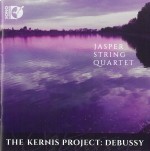 I see that I’ve pretty much used up my allotment of words for the month already, but there is another disc that I’ve been enjoying and wanted to mention. The Kernis Project: Debussy (Sono Luminus DSL-92233 sono-luminus.squarespace.com) is the culmination of the Jasper String Quartet’s “decade-long journey with Aaron Jay Kernis’ music for string quartet… [during which] we realized his special voice and our connection to his music’s ability to capture both the complexity of the world and the simplicity of the moment.” Having recorded Kernis’ first quartet, paired with Beethoven in 2011 and his second, paired with Schubert the following year, the Jaspers commissioned Kernis to write a third, which he subtitled “River” and completed in 2015. The American composer (b.1960) says it “is a significant departure from my earlier two quartets, which looked to the distant past for form and inspiration. Instead, this new work dispenses with classical structure and influences almost completely, touching continually on processes of change and flux.” That being said, it is an extended work lasting more than 35 minutes and showing the influence of both Beethoven’s Op.131, particularly in the sombre Cavatina fourth movement, and Bartók’s String Quartet No.4, with “night music” aspects in both the second movement Flow/Surge and third Mirrored Surface – Flux – Reflections, and from which it takes its five-movement form.
I see that I’ve pretty much used up my allotment of words for the month already, but there is another disc that I’ve been enjoying and wanted to mention. The Kernis Project: Debussy (Sono Luminus DSL-92233 sono-luminus.squarespace.com) is the culmination of the Jasper String Quartet’s “decade-long journey with Aaron Jay Kernis’ music for string quartet… [during which] we realized his special voice and our connection to his music’s ability to capture both the complexity of the world and the simplicity of the moment.” Having recorded Kernis’ first quartet, paired with Beethoven in 2011 and his second, paired with Schubert the following year, the Jaspers commissioned Kernis to write a third, which he subtitled “River” and completed in 2015. The American composer (b.1960) says it “is a significant departure from my earlier two quartets, which looked to the distant past for form and inspiration. Instead, this new work dispenses with classical structure and influences almost completely, touching continually on processes of change and flux.” That being said, it is an extended work lasting more than 35 minutes and showing the influence of both Beethoven’s Op.131, particularly in the sombre Cavatina fourth movement, and Bartók’s String Quartet No.4, with “night music” aspects in both the second movement Flow/Surge and third Mirrored Surface – Flux – Reflections, and from which it takes its five-movement form.
I have mentioned the overlap of literature and music in my life, and I was intrigued to read in the program note to this quartet that it was influenced by two books that both had a profound effect on me: Jean-Christophe by Romain Rolland, and My Struggle (actually a series of six books) by Karl Ove Knausgaard. First read at an age when “3/4 of the [Rolland] book would’ve been incomprehensible to me,” Kernis says that the central image of the Rhine River and “its inexorable flow” were indelibly etched in his memory. “While the Romanticism of the book does not have any parallel in the music at all, its intense emotions do, and the River and its continual movement became central to the conceptualization of my work.” Regarding My Struggle, Kernis says it was “vitally influential for my musical processes… The book sets forward the trajectory of one man’s life, the flow of the quotidian along with meditations on the psychological underpinnings of the center of existence.” As with Schumann’s Carnaval, knowledge of the backstory is not essential to enjoyment of the work. I listened to this compelling piece a number of times before I read the liner notes and discovered the serendipitous connection to my own life interests.
The companion piece is a beautifully nuanced performance of one of my favourite pieces of music, Debussy’s String Quartet in G Minor Op.10. As an amateur cellist I’m proud of the fact that I’ve advanced to the stage where I can reasonably attempt, and obtain satisfaction from, performing with friends some of the great chamber works that influenced me in my formative years. This has included trios, quartets and quintets by Beethoven, Mozart, Schubert, Borodin, Felix and Fanny Mendelssohn, Robert and Clara Schumann, and even a few movements from the modern canon by Ravel, Webern, Shostakovich and sometime WholeNote contributors Colin Eatock and Daniel Foley. One that I’ve not yet tried is this Debussy quartet, and I’d like to thank the Jaspers for inspiring me to rectify this situation in the near future. Incidentally, although I don’t see any mention of a Canadian connection in the members’ biographies, the group, which was formed at the Oberlin Conservatory in Ohio, takes its name from Jasper National Park in Alberta.
We invite submissions. CDs, DVDs and comments should be sent to: DISCoveries, WholeNote Media Inc., The Centre for Social Innovation, 503 – 720 Bathurst St. Toronto ON M5S 2R4.
David Olds, DISCoveries Editor
discoveries@thewholenote.com


